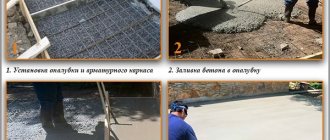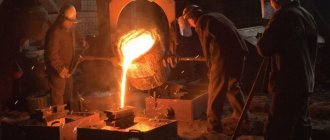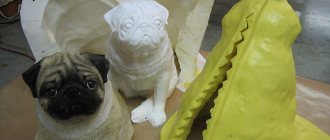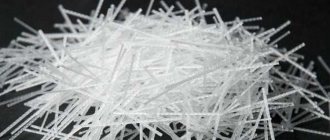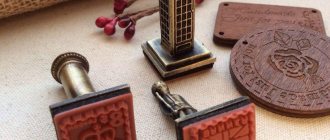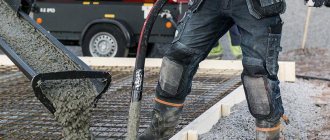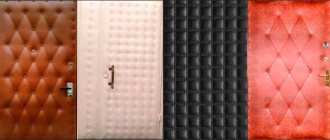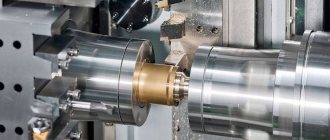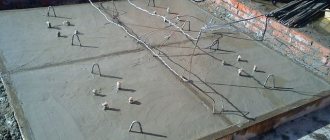The technology of creating stamped concrete has confidently entered the construction industry and is already widely used. With the help of stamps that imitate various materials and shapes, an ordinary surface filled with concrete solution is transformed into a decorative miracle and pleases the eye for a long time, while maintaining all the advantages of the concrete composition. Other names for artificial stone transformed in this way are pressed, decorative, top concrete, printed.
The essence and possibilities of using this technology
Stamped concrete is ordinary concrete, onto the surface of which decorative embossing is applied using special stamps. The relief pattern can imitate any material: brick, paving stones, boards, animal skins, weathered stone, cracked earth. You can choose stamps with leaf patterns, dinosaur footprints, and animal figures.
Stamped concrete is especially popular when decorating terraces, patios, areas near swimming pools, garden paths, sidewalks, gazebos, floors in restaurants and exhibition halls. This technology becomes indispensable for complex restoration work. For example, when it is necessary to recreate a destroyed part of an ancient pavement. It is often not possible to find exactly the same materials that have aged naturally. And with the help of stamped concrete technology, exact copies of existing old brick or half-erased stone can be easily created.
Variety of stamps for printed concrete
The first stamps for stamped concrete were made of cast aluminum and were massive molds equipped with handles. Such matrices are well suited for simulating ordinary brick or stone patterns. But they are unable to copy complex textures. Modern polyurethane stamps are a completely different matter. They are cast on real materials, the texture of which must be copied. As a result, incredibly authentic textural effects can be achieved using polyurethane molds.
Ready-made stamps can be purchased at many construction stores or centers. When choosing, you should pay attention to the degree of rigidity of the shape. The denser the stamp, the easier it is to create a clearly visible design. Forms that are too soft and pliable are more difficult to work with and require more effort during the printing process.
Coating coloring
Coloring of a monolithic coating is carried out by manually dispersing the dye-hardener.
Hints: movement on the treated surface is not allowed, therefore, at the time of spraying the dye, workers performing this type of work must move along the areas adjacent to the monolithic coating.
Dispersing the color hardener
Surface painting is carried out in several stages:
- First, 60–70% of a colored dye-hardener is applied to the surface to be treated. The powder is evenly rubbed with special smoothers.
- After this, the remaining dye dissipates. Using plaster trowels, the hardener is rubbed into the surface of the coating with the necessary force until the base acquires a dense, uniform color. The edges of the platform are processed with corner trowels.
- The technical break after applying the dye and before stamping the design must be at least one hour.
Coating relief printing
Once the concrete reaches initial strength (with a small force the base should be pressed to a depth of 6–8 mm), a release agent is dispersed onto the surface, preventing the solution from adhering to the base of the matrix.
The quantity and thickness of the separator layer is determined experimentally.
Tips: You need to know that a large amount of reagent can reduce the clarity of the print, and an insufficient amount will cause the stamps to become wet.
Immediately after applying the decoupling mixture, the surface is stamped with texture matrices.
Expanding the matrices
- The first stamps are laid along the near edge of the concrete pad. The edges of the matrices must be placed tightly against each other in order to obtain clear joining lines on the surface, eliminating manual modification of the design.
- After the entire set of dies has been distributed over the surface, using hand tampers, they begin to press the stamps into the base of the coating. Impacts with a tamper must be applied carefully and evenly over the entire plane of the mold.
We stamp concrete
- Stamping of the relief is continued until the outer edge of the matrix sits tightly, without gaps, on the base of the platform. The depth of the relief, depending on the stamps and the selected pattern, is 5–10 mm.
- After completing the first stage, the forms are transferred to another free area of the surface and continued in the same sequence.
- The pattern is printed at the edge of the pad using soft polyurethane matrices with the same structure as the main stamps.
- When removing the stamp, care must be taken to ensure that the hardener does not stick to the base of the matrix.
After stamping work is completed, the surface must be covered, and any movement within the boundaries of the site must be prohibited until finishing occurs.
Self-production technology
The technology of stamped concrete is quite simple, but you should only take it on if you already have some skills in working with concrete. Otherwise, the result may not be what you expected. Problems may arise for the following reasons:
- concrete hardens quickly, after which the use of stamps does not produce clear embossing on the surface;
- To perform embossing using stamps, you need to apply physical force;
- errors in embossing a concrete surface are difficult to correct;
- stamped concrete technology requires the worker to be able to use special tools to form and smooth the surface.
Once you are confident that you can handle the potential problems, you can begin creating the concrete pad and performing the stamping work.
Step 1. Preparing the concrete site
The basis for stamping is a regular concrete platform with reinforcement, made of concrete grade M350 and higher.
Technology for creating such a platform:
- using pegs and a cord, mark the boundaries of the area where stamping will be carried out;
- remove the top layer of soil (depth 15-20 cm), compact the soil bottom;
- pour a crushed stone cushion (10-15 cm thick) onto the bottom of the excavation and tamp it down;
- formwork made of boards is installed along the border of the site;
- lay a reinforcing mesh in the formwork, raising it above the ground level by at least 3-5 cm (by placing stones and bricks under the mesh);
- concrete is mixed manually, using a concrete mixer, or ordered ready-made;
- concrete is poured into the formwork, a metal rule is used to obtain the required level of the site;
- compact the concrete with a vibrating screed;
- The top layer of concrete is smoothed with a trowel, achieving a smooth and uniform surface.
Step #2. Application of color hardener
A colored hardener is applied to still fresh concrete, which simultaneously colors the surface and increases its strength. A colored hardener is a powder that contains coloring pigments, a binder filler and ground particles of granite and quartz sand. Due to the dispersion of the mixture, its particles penetrate into the pores of concrete and fill them. The concrete surface becomes more dense and durable. At the same time, the particles give the concrete a lasting color (about 30 tones to choose from).
Work on applying a colored hardener begins after the initial setting of the concrete surface. You can focus on the moment when all the water that appears from the surface has evaporated.
Colored hardener powder is scattered over the concrete surface manually, from the center of the site to the edges. At the same time, they perform movements similar to throwing a bowling ball. Scoop up a portion of the powder, move your hand back and with a sharp movement throw the mixture forward from waist level. This principle of applying powder minimizes the number of particles flying through the air.
The first layer of hardener should be absorbed into the concrete, which takes 5-10 minutes. During this time, the surface of the concrete is smoothed by rubbing the dye into it using a magnesium smoother. Corners are also processed using corner smoothers to make them curved and neat.
Then a second layer of colored hardener is applied. It is necessary to paint the surface more evenly and compact it. The powder is applied in exactly the same way as in the first case. After application, the surface is leveled with a steel trowel.
Step #3. Application of the release agent
The release ink prevents the concrete from sticking to the dies during the printing process. In addition, it additionally colors the surface of the concrete, giving it subtle shades of color. The release agent is available in the form of a dry powder or liquid. Most often, powder is used, applying it to the surface of the concrete with a wide brush (brush).
The brush is immersed in a bucket with a separating component so that the bristles are evenly covered with powder. Then, holding the brush at waist level, throw your hand forward and “spray” the powder over the surface of the concrete.
After painting, the corners of the area are treated with textured sandpaper.
Step #4. Surface stamping
Before you start stamping, you need to make sure that the concrete has acquired the required degree of plasticity and has become similar in consistency to plasticine. If you start stamping too early, the concrete surface will not be able to support the weight of the workers and maintain the print lines. If you are late, you will have to put more effort into the stamps to print clearly. In addition, the texture of the stamps may not be imprinted at all on concrete that is too dense, especially at the end of the job.
To determine the degree of density, just press your finger on the concrete surface at several points on the site. If there are prints left with a depth of 4-6 mm, then stamping can begin. You can also check it another way: place a stamp on a concrete surface (at the edge of the site) and step on it. The stamp must support the weight of the worker, not sink into the concrete, and not slide across the surface.
If all tests pass successfully, you can begin stamping. The stamps are laid out on the concrete surface, one after another. Manufacturers often number the stamps (1, 2, 3... or A, B, C...) to indicate the desired sequence of their placement in the printed design.
To imprint the texture of the stamps into the concrete, you can often simply step on them. Sometimes light hand tampers are used for this.
After the prints are made, the concrete surface is left to cure for 12-24 hours.
Step #5. Elimination of defects
On the concrete surface, where the dies meet, a slight displacement of the cement mortar often occurs. Sometimes, due to insufficient compaction, the seams of the printed pattern may appear blurry and indistinct. To correct surface defects, a hand roller is used along the seams and joints, and uneven surfaces are smoothed out with textured sandpaper.
Step #6. Cutting shrink joints
Several cut seams in the slab provide stress relief and prevent cracks. Such joints can be made in still fresh concrete using a special cutter. Or cut the seams with a grinder after the concrete has dried.
Step #7. Surface washing
The next day, wash the surface. Use a hose to wash off excess release agent. Afterwards, an acid wash (with hydrochloric acid) is performed to obtain the desired effect of a combination of two colors on the surface. During this process, the pores of the concrete also open, which promotes better interaction of its surface with the sealant.
Step #8. Applying sealant
The next day, a sealant varnish is applied to the concrete. It performs a number of functions:
- protects the surface from abrasion and wear, as well as from the penetration of oils and chemicals;
- gives the surface a shine of varying saturation (from barely noticeable satin to rich varnish);
- enhances the color saturation of concrete;
- simplifies the care of the treated surface.
The sealant is applied with a roller, rolling it over the surface. But, if the stamped texture has deep imprints, when applying sealant it is advisable to combine rolling with a roller with additional processing with a brush. Typically 2-3 coats of sealant are required.
After the sealant has dried, the stamped surface will be completely ready for use.
Characteristics of the material and composition of mixtures
Stamped (printed) coatings are a comprehensive system for finishing monolithic surfaces, during which the following are used:
- concrete mixtures of strength class B20-B25;
- artistic stamps on concrete;
- coloring dry mixtures-hardeners;
- disconnecting reagents;
- strengthening protective impregnations.
Decorative coatings equipped with printing can be successfully used as elements of architectural decoration of the following objects:
- pedestrian paths;
- parking lots;
- gardening coverings;
- when installing floors both outside and indoors;
- for decorating retaining walls, plinths of residential and public buildings;
- blind area;
- steps of stairs.
Decorative design of the basement of the building
In addition, using this technology it is possible to produce prefabricated wall panels, slabs for interior and exterior surface finishing, as well as reconstruct existing coatings.
Materials
Printed concrete is a separate type of building materials, consisting of the same components as traditional heavy mortars. White or gray Portland cement of a grade not lower than M400 can be used as binders.
Quartz sand and crushed stone of various rocks with a grain size of 0.25–10 mm are used as fine and coarse aggregates. Depending on the technological requirements and production conditions, various additives can be added to the mixtures - plasticizers, stabilizers, etc.
Colored dry mixture-hardener
Color hardener
Colored hardeners are ready-made dry mixtures for strengthening and coloring concrete printed coatings. The colored powder is applied by dry scattering onto a freshly laid and slightly hardened surface.
Purpose of the hardener:
- provides the most uniform and rich surface color;
- increases the density of the base;
- increases wear resistance;
- gives resistance to atmospheric factors;
- helps create a coating that is resistant to ultraviolet radiation, acids, alkalis, etc.
The hardener consumption is on average 2–4 kg/m2.
Disconnector compounds
Release agent for stamped concrete
A hydrophobic release agent is a dry mixture of various colors and shades, the main function of which is to prevent the printing matrix (stamp) from sticking to the wet concrete surface at the time of creating the relief.
The release mixture is applied in a thin layer using a wide brush with long, soft bristles. The solution binds firmly to the surface, creating a blackening effect on the coating.
The standard consumption of the disconnecting agent is 0.2 kg/m2 of surface.
